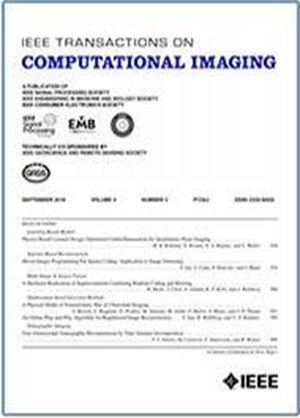基于电阻抗断层成像低秩矩阵恢复的脉冲运动伪影鲁棒预处理
IF 4.8
2区 计算机科学
Q2 ENGINEERING, ELECTRICAL & ELECTRONIC
引用次数: 0
摘要
电阻抗断层扫描(EIT)是一种有价值的床边工具在重症医学和肺炎。然而,与身体和电极运动相关的伪影,特别是脉冲运动伪影,阻碍了其在临床场景中的常规应用。现有的EIT数据预处理或成像算法大多不能有效地解决这一问题。本文提出了一种新的方法,即鲁棒预处理EIT (RP4EIT),利用低秩矩阵恢复的概念对EIT边界电压进行预处理。它旨在抵抗脉冲运动伪影,进一步提高成像质量。为了在正常测量和污染数据上获得良好的性能,我们设计了一种采用鲁棒统计分析和低秩恢复的两阶段去噪算法。具体来说,EIT边界电压首先被表示为矩阵,其中行和列分别对应于通道和帧。然后,对矩阵中被脉冲噪声破坏的项进行识别,并将其视为缺失元素。随后,RP4EIT利用低秩属性来恢复缺失的组件。这样做,脉冲运动伪影从EIT测量中消除。进一步,建立了RP4EIT的收敛性保证。实验结果表明,RP4EIT能够去除边界电压中的脉冲运动伪影,恢复的数据能够产生高质量的EIT图像。本文章由计算机程序翻译,如有差异,请以英文原文为准。
Robust Preprocessing of Impulsive Motion Artifacts Using Low-Rank Matrix Recovery for Electrical Impedance Tomography
Electrical impedance tomography (EIT) is a valuable bedside tool in critical care medicine and pneumology. However, artifacts associated with body and electrode movements, especially impulsive motion artifacts, hinder its routine use in clinical scenarios. Most of the existing algorithms for EIT data preprocessing or imaging cannot effectively address this issue. In this paper, we propose a novel method, namely, robust preprocessing for EIT (RP4EIT), to preprocess EIT boundary voltages using the concept of low-rank matrix recovery. It aims to resist impulsive motion artifacts and further to enhance the imaging quality. To attain good performance on both the normal measurements and contaminated data, we design a two-stage denoising algorithm using robust statistical analysis and low-rank recovery. Specifically, EIT boundary voltages are first formulated as a matrix, where the rows and columns correspond to the channels and frames, respectively. Then, the entries corrupted by impulsive noise of the matrix are identified and considered as missing elements. Subsequently, RP4EIT exploits the low-rank property to restore the missing components. In doing so, the impulsive motion artifacts are eliminated from EIT measurements. Furthermore, the convergence guarantee of RP4EIT is established. Experimental results on phantom and patient data demonstrate that RP4EIT is able to remove the impulsive motion artifacts from boundary voltages and the recovered data yield high-quality EIT images.
求助全文
通过发布文献求助,成功后即可免费获取论文全文。
去求助
来源期刊

IEEE Transactions on Computational Imaging
Mathematics-Computational Mathematics
CiteScore
8.20
自引率
7.40%
发文量
59
期刊介绍:
The IEEE Transactions on Computational Imaging will publish articles where computation plays an integral role in the image formation process. Papers will cover all areas of computational imaging ranging from fundamental theoretical methods to the latest innovative computational imaging system designs. Topics of interest will include advanced algorithms and mathematical techniques, model-based data inversion, methods for image and signal recovery from sparse and incomplete data, techniques for non-traditional sensing of image data, methods for dynamic information acquisition and extraction from imaging sensors, software and hardware for efficient computation in imaging systems, and highly novel imaging system design.
 求助内容:
求助内容: 应助结果提醒方式:
应助结果提醒方式:


